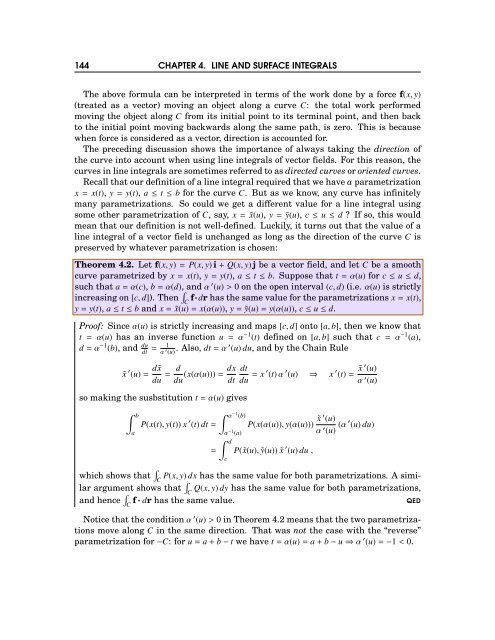Michael Corral: Vector Calculus
Michael Corral: Vector Calculus
Michael Corral: Vector Calculus
You also want an ePaper? Increase the reach of your titles
YUMPU automatically turns print PDFs into web optimized ePapers that Google loves.
144 CHAPTER 4. LINE AND SURFACE INTEGRALS<br />
The above formula can be interpreted in terms of the work done by a force f(x,y)<br />
(treated as a vector) moving an object along a curve C: the total work performed<br />
moving the object along C from its initial point to its terminal point, and then back<br />
to the initial point moving backwards along the same path, is zero. This is because<br />
when force is considered as a vector, direction is accounted for.<br />
The preceding discussion shows the importance of always taking the direction of<br />
the curve into account when using line integrals of vector fields. For this reason, the<br />
curvesinlineintegralsaresometimesreferredtoasdirectedcurvesororientedcurves.<br />
Recallthatourdefinitionofalineintegralrequiredthatwehaveaparametrization<br />
x= x(t), y=y(t), a≤t≤b for the curve C. But as we know, any curve has infinitely<br />
many parametrizations. So could we get a different value for a line integral using<br />
some other parametrization of C, say, x= ˜x(u), y=ỹ(u), c≤u≤d? If so, this would<br />
mean that our definition is not well-defined. Luckily, it turns out that the value of a<br />
line integral of a vector field is unchanged as long as the direction of the curve C is<br />
preserved by whatever parametrization is chosen:<br />
Theorem 4.2. Let f(x,y)=P(x,y)i+Q(x,y)j be a vector field, and let C be a smooth<br />
curve parametrized by x= x(t), y=y(t), a≤t≤b. Suppose that t=α(u) for c≤u≤d,<br />
such that a=α(c), b=α(d), andα ′ (u)>0on the open interval (c,d) (i.e.α(u) is strictly<br />
increasingon[c,d]). Then ∫ C f·drhasthesamevaluefortheparametrizations x= x(t),<br />
y=y(t), a≤t≤band x= ˜x(u)= x(α(u)), y=ỹ(u)=y(α(u)), c≤u≤d.<br />
Proof: Sinceα(u) is strictly increasing and maps [c,d] onto [a,b], then we know that<br />
t = α(u) has an inverse function u = α −1 (t) defined on [a,b] such that c = α −1 (a),<br />
d=α −1 (b), and du<br />
dt= 1<br />
α ′ (u) . Also, dt=α′ (u)du, and by the Chain Rule<br />
˜x ′ (u)= d˜x<br />
du = d dx<br />
(x(α(u)))=<br />
du dt<br />
so making the susbstitution t=α(u) gives<br />
∫ b<br />
a<br />
P(x(t),y(t))x ′ (t)dt=<br />
=<br />
∫ α −1 (b)<br />
α −1 (a)<br />
∫ d<br />
c<br />
dt<br />
du = x′ (t)α ′ (u) ⇒ x ′ (t)= ˜x′ (u)<br />
α ′ (u)<br />
P(x(α(u)),y(α(u))) ˜x′ (u)<br />
α ′ (u) (α′ (u)du)<br />
P(˜x(u),ỹ(u)) ˜x ′ (u)du,<br />
which shows that ∫ P(x,y)dx has the same value for both parametrizations. A similar<br />
argument shows that ∫ Q(x,y)dy has the same value for both parametrizations,<br />
C<br />
C<br />
and hence ∫ C f·dr has the same value.<br />
QED<br />
Notice that the conditionα ′ (u)>0in Theorem 4.2 means that the two parametrizations<br />
move along C in the same direction. That was not the case with the “reverse”<br />
parametrization for−C: for u=a+b−t we have t=α(u)=a+b−u⇒α ′ (u)=−1








